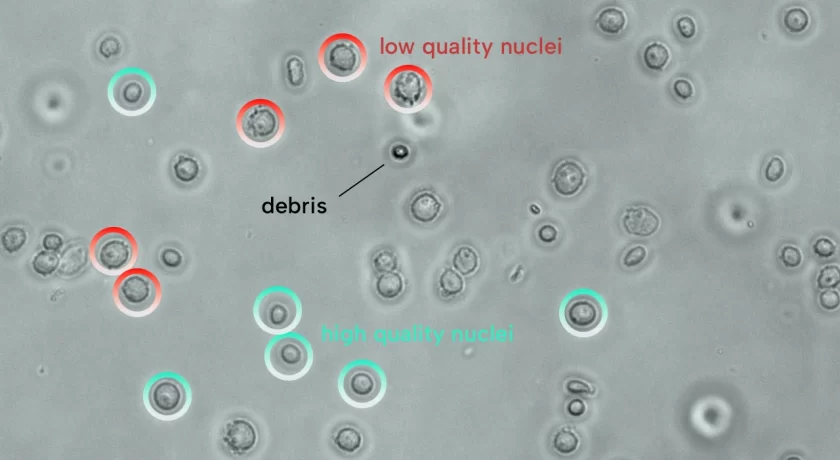
Today, single-cell RNA sequencing in Phase-II clinical trials serves one main goal. It is used to further develop an understanding of an authorized drug’s mechanism of action, which results are directly linked to positive or negative disease outcomes in actual patients.
Phase-II clinical trials test drugs on selected patient groups to evaluate the effectiveness of treatment and further evaluate safety. In addition, as a secondary objective, researchers in a clinical trial may aim to elucidate the in vivo mechanism of action of the drug. Moreover, the aim may be to find prognostic markers for therapy effect or, in other patients, therapy resistance. And novel combinations of existing drugs can be tested in Phase-II clinical trials. Similarly, explaining the mechanism of the combinatory effects is an important secondary objective.
Single-cell sequencing can be fruitfully employed to achieve secondary objectives in clinical trials, as the examples below show.
How prevalent is single-cell sequencing in Phase-II clinical trials?
Clinicaltrials.gov lists 22 Phase-II clinical trials truthfully tagged with ‘single cell sequencing technology’ (list). Of these, eight studies are associated with a publication that details the single-cell sequencing implementation and trial results.
Next to these, at least five Phase-I clinical trials employing single-cell RNA sequencing (scRNA-seq) are linked to published results. We have examined these clinical trials in a previous blog post.
Highlighted Phase-II studies
This blog post details six currently documented Phase-II clinical trials that employ single-cell sequencing. They are all cancer drug trials. Yet, each research group has a slightly different purpose for the trial and applies single-cell sequencing in a different way.
Two test a new cancer vaccine and use single-cell sequencing to generate a comprehensive profile of the immune response, one per clonality and one per gene expression analysis. Two others analyze a promising new combination of existing drugs. They attempt to clarify the combinatory effects by single-cell analysis on paired pre- and on-treatment biopsies, one focusing on the tumor and the other on the microenvironment. Yet another study zooms in on the mechanism of therapy resistance with the purpose of validating prognostic markers for earlier resistance detection. A final publication shows single-cell sequencing applied to reveal the mechanism of antitumor immune action elicited by a kinase inhibitor and to analyze the source and cure of toxicity in disease-modeling mice.
Jump to a section in this blog:
- Immune profiling after adjuvant multiple myeloma vaccination.
- Characterize immunotherapy effect in colorectal cancer.
- Study a combinatorial therapeutic effect in operable lung cancer.
- Understand early therapy resistance in metastatic esophageal cancer.
- Dissect effects and immunotoxicity in head and neck cancer.
- Takeaways
- More studies
Understand the impact of single-cell sequencing to drug development.
Pioneering researchers now leverage the unique capacities of single-cell to elucidate your drug's mechanism of action, resistance, or toxicity. Download our eBook that covers single-cell sequencing in the drug discovery pipeline.
Characterize the immune response of adjuvant multiple myeloma vaccine
- Indication: Multiple myeloma
- Therapy modality: Cancer vaccine
- scRNA-seq application: Mechanism of action study
- Single-cell analyses: Immune profiling (clonotyping) of immune response to vaccine at 90-days and at 1-year posttransplant.
Summary
Two Phase-II clinical trials employed single-cell RNA to study the mechanism of action of multiple myeloma vaccines. In the most recent study, published in December 2023, Chung et al. study the efficacy of a dendritic cell/myeloma fusion vaccine after autologous stem cell transplant (ASCT). ASCT follows high-dose chemotherapy when possible, to replace the bone marrow stem cells lost by chemo. Patients then receive maintenance therapy to help keep the myeloma from growing back, usually with the drug lenalidomide.
The vaccination of this trial can induce the expansion of myeloma-reactive lymphocytes after a transplant. Here, it’s tested in the pharmaceutical context of lenalidomide and another drug. Effects on patients’ response rates were slightly positive but ultimately not significant.However, the study showed a significant increase in myeloma-reactive CD8+ T cells, indicative of tumor-specific immunity. With 10x Genomics Immune Profiling, the authors could detect a clonal expansion of these T cells, with some shared dominant clones among patients, persisting 1 year after transplantation.
This information, the authors note, corresponded to a second phase II clinical trial testing a multiple myeloma vaccine after transplantation (Qazilbash et al., 2022). It, too, saw no significantly improved response in patients. Yet, it did observe increased expression of immune response genes using a single-cell RNA sequencing solution called Nanostring. Both studies stress that a combinatory therapy strategy in addition to the vaccine may be necessary. Importantly, the results from single-cell sequencing support the pursuit of vaccine implementation despite a lack of patient response.
Study the combinatorial effect of BRAF inhibitors and immunotherapy in colorectal cancer
- Indication: Metastatic colorectal cancer
- Therapy modality: Small molecule inhibitors/immunotherapy
- scRNA-seq application: Mechanism of action
- Single-cell analyses: Single-cell gene expression profiling before and during treatment
Summary
One of the first Phase II clinical trials to incorporate systematic single-cell sequencing of paired pre- and on-treatment tumor biopsies from patients started in 2018 and saw publication in 2023 (Tian et al.). In this trial, the research team focused on unraveling the mechanism of a novel combination therapy approach for targeting metastatic colorectal cancer: BRAF/MEK inhibitors combined with checkpoint inhibitors.
The study showed that survival rates were three times higher with the combination than with standalone BRAF/MEK inhibitors. To better understand this combinatorial effect, the team used single-cell transcriptomics and Immune Profiling on 23 tumors. They observed gene expression changes that indicated activated tumor cell-intrinsic immune programs. Specifically, types I and II interferon response, antigen-presenting genes, and T-cell recruiting chemokines. The findings were directly linked to decreased tumor growth and notably improved progression-free survival.
Per the single-cell data, the team could mimic the gene expression changes in patient-derived organoid model systems. This helped validate that MAPK inhibition (a downstream target of BRAF/MEK inhibitors) drove immune program induction and pinpoint the mechanism of action of this drug combination.
Study the combinatorial effect of chemo + two immunotherapy drugs in operable lung cancer
- Indication: Operable non-small cell lung cancer
- Therapy modality: Small molecule inhibitors, immunotherapy
- scRNA-seq application: Study mechanism of action
- Single-cell analyses: Cell-type identification of tumor microenvironment before and during treatment & gene expression analysis.
Summary
Nivolumab (NIVO) and Ipilimumab (IPI) are successful immune checkpoint inhibitors of lung tumors. As they have different mechanisms, their combinatorial effect was hypothesized and established in metastatic non-small cell lung cancer (NSCLC) patients in early 2023 (Brahmer et al.).
The NEOSTAR trial researched whether adding IPI to the current first-line treatment of chemotherapy, and NIVO helped prevent tumor recurrence in patients with non-metastatic. To measure how the combination affected the tumor and the anti-tumor immune system, the NEOSTAR team used single-cell sequencing (Cascone et al., 2023).
They found the major pathological response to be 20% higher in patients with chemo + NIVO + IPI compared to without IPI, with seemingly acceptable levels of toxicity. To investigate the mechanism behind this outcome, they used the 10x Genomics Immune Profiling solution. They observed more favorable cell types in patients treated with additional IPI (more: CD8+ T, CD4+ T, B, and NK cells, less: regulatory T cells). Single-cell gene expression analysis moreover showed enrichment in genes linked to antitumor behavior.
Here, the single-cell data provide additional evidence that the chemo + NIVO+ IPI treatment elicited a stronger antitumor immune response.
Understand early therapy resistance in metastatic esophageal cancer
- Indication: Metastatic esophagogastric cancer
- Therapy modality: Chemotherapy including antibody therapy
- scRNA-seq application: Study mechanism of therapy resistance.
- Single-cell analyses: Identify and characterize tumor clonal dynamics before and during treatment.
Summary
Recurrent tumors caused by the later outgrowth of therapy-resistant clones is an important focus point in current-day oncology. Here, resistance is associated with a baseline heterogeneity within a tumor, and researchers aim to find reliable markers for the various tumor clones present as well as protocols by which these markers best inform therapy choices.
A Phase-II clinical trial (Maron et al., 2023) in metastatic HER2-positive esophagogastric cancer patients employs single-cell RNA sequencing to study the clonal heterogeneity in tumors before treatment and how clonality changes during therapy. The study’s goal is twofold:
- To gauge the importance of baseline tumor heterogeneity in the patient.
- To validate prognostic markers in terms of plasma circulating tumor DNA (ctDNA) dynamics and create an early detection method for therapy-resistant clones.
In the study, the researchers could correlate high heterogeneity (detected by serial ctDNA monitoring) with inferior disease outcome. Complete clearance of tumor ctDNA after nine weeks correlated with a better prognosis. Moreover, scRNA-seq on biopsy material revealed a good therapeutic effect on HER2-positive clones, supporting the ctDNA findings.
Conversely, the researchers observed in some patients an expansion of clones in which scRNA-seq detected transcriptional resistance programs (associated with expressed MT1H, MT1E, MT2A & MSMB genes). This latter observation correlated with a worse prognosis, which gives reason to focus on the detected genes as future therapeutic targets. Perhaps as important, it also showcases the potential of scRNA-seq in a diagnostic/prognostic setting to support biomarker identification.
Dissect kinase inhibitor effects and immunotoxicity in head and neck cancer
- Indication: Head and neck cancer
- Therapy modality: Kinase inhibitors (cancer growth blockers) as immunotherapy
- scRNA-seq application: Study mechanism of action & mechanism of toxicity
- Single-cell analyses: Gene expression analysis & clonal dynamics analysis of the tumor microenvironment and immune system in different treatment regimens (in human and mice)
Summary
Overactive phosphoinositide 3-kinase (PI3K) is observed in various cancers and immune disorders, leading to the development of multiple PI3K inhibitors. Currently, at least six are approved, and over 35 are in clinical trials (clinicaltrials.gov). These inhibitors not only directly target cancer cells but also trigger an antitumor immune response. In a phase-II clinical trial, single-cell sequencing revealed increased cytotoxicity genes in infiltrating T cells and a rise in activated regulatory T (Treg) cells (Eschweiler et al., 2022). The latter implied that a Treg displacement from the tumor microenvironment may be part of the inhibitor’s mechanism of action. However, more than half of the patients discontinued treatment due to immune-related adverse effects, specifically colonic inflammations.
To further investigate, the researchers employed a mouse model resembling patient conditions. In mice, single-cell sequencing showed that PI3K inhibitors substantially affected a specific Treg subset in the colon. These immunosuppressive Tregs were replaced by clonally expanded (i.e., activated) pathogenic T cell populations, leading to toxicity. Interestingly, the level of toxicity correlated with dosing regimens and intermittent dosing curbed toxicity in mice. The authors propose testing intermittent dosing in clinical trials and stratifying patients based on their baseline Treg concentration in the tumor microenvironment to enhance efficacy.
Takeaways
The exploitation of single-cell RNA sequencing in Phase-II clinical trials is sporadic, yet versatile. Single-cell sequencing is used today almost exclusively in trials for (immuno-)oncological applications, including cancer vaccines. Here, the studies leverage two of single-cell technology’s unique capabilities:
- Mapping out immune cell clonality and thereby characterizing the immune therapeutic or, conversely, immunotoxicity response.
- Disentangling tumor heterogeneity and thereby pinpointing prognostically relevant tumor clones.
More Phase-II studies
- Coupling whole exome sequencing data to scRNA-seq data to study tumor evolution and find mechanisms of action in responders in gastric cancer (Kwon et al., 2021).
- Cell type identification of the immune system in pembrolizumab (antibody therapy) responders among hepatocellular carcinoma patients (Hong et al., 2022).
- A Phase-II study of immunotherapy combination prembrolizumab + capecitabine in advanced biliary tract carcinoma patients. scRNA-seq in one partial responder provided additional evidence that immune infiltration and clonal evolution played a role in the response (Monge et al., 2022).
Find out more
Find out more information on single-cell sequencing application across the drug discovery pipeline, from biomarker identification to lead optimization, and from preclinical research to clinical studies.




